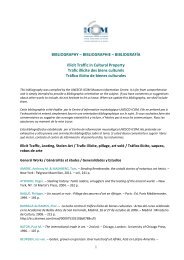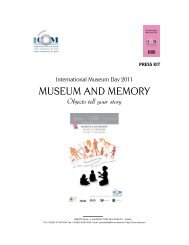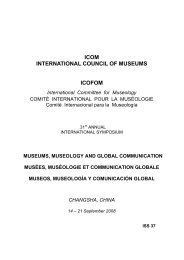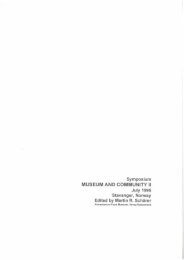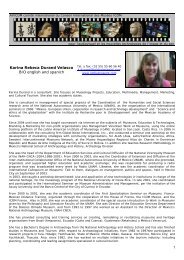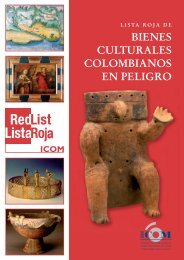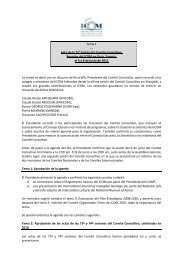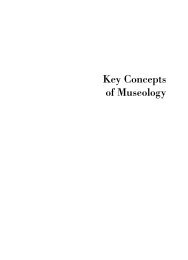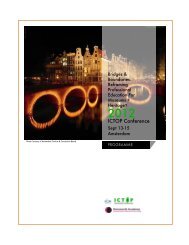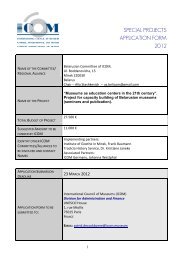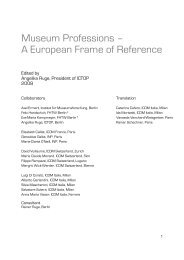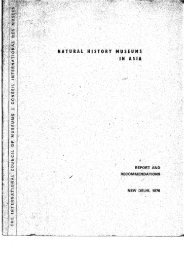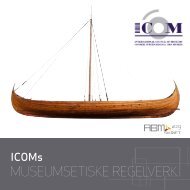1 Minutes of the 26th ICFA Annual Conference in Coburg with visits ...
1 Minutes of the 26th ICFA Annual Conference in Coburg with visits ...
1 Minutes of the 26th ICFA Annual Conference in Coburg with visits ...
You also want an ePaper? Increase the reach of your titles
YUMPU automatically turns print PDFs into web optimized ePapers that Google loves.
<strong>M<strong>in</strong>utes</strong> <strong>of</strong> <strong>the</strong> <strong>26th</strong> <strong>ICFA</strong> <strong>Annual</strong> <strong>Conference</strong> <strong>in</strong> <strong>Coburg</strong> <strong>with</strong> <strong>visits</strong> to Weimar, Gotha,<br />
Altenburg and Dresden<br />
3 October to 7 October 2006<br />
F<strong>in</strong>e Art Collections <strong>in</strong> <strong>the</strong>ir Historical Contexts<br />
Head <strong>of</strong> <strong>the</strong> organis<strong>in</strong>g committee: Dr Klaus Weschenfelder, Director. Kunstsammlungen der Veste <strong>Coburg</strong> (and <strong>ICFA</strong><br />
Vice-President)<br />
Tuesday 3rd October<br />
18.30 to 21.30 Welcome reception<br />
The conference participants were welcomed <strong>with</strong> a buffet d<strong>in</strong>ner reception at Schloss Ehrenburg <strong>in</strong> <strong>the</strong> old and<br />
picturesque centre <strong>of</strong> <strong>Coburg</strong>. The open<strong>in</strong>g words by Dr Klaus Weschenfelder and Dr Stephen Lloyd were followed by<br />
a greet<strong>in</strong>g from <strong>the</strong> participants to <strong>the</strong> organisers by Dr Frode Ernst Haverkamp (National Museum <strong>of</strong> Art, Architecture<br />
and Design, Oslo, Norway). The warm and friendly atmosphere <strong>of</strong> <strong>the</strong> get-toge<strong>the</strong>r, well known to all active <strong>ICFA</strong><br />
members, also promised for <strong>the</strong> newcomers four very agreeable days to follow.<br />
Schloss Ehrenburg was built dur<strong>in</strong>g <strong>the</strong> 16th century, on <strong>the</strong> grounds <strong>of</strong> a former Franciscan cloister, as <strong>the</strong> city<br />
residence <strong>of</strong> <strong>the</strong> Duke <strong>of</strong> <strong>Coburg</strong>. The new gothic facade <strong>of</strong> <strong>the</strong> castle, designed by <strong>the</strong> architect Karl Friedrich von<br />
Sch<strong>in</strong>kel, was built <strong>in</strong> early 19th century dur<strong>in</strong>g <strong>the</strong> reign <strong>of</strong> Duke Ernst I.<br />
A visit to <strong>the</strong> ducal apartments, guided Mr Wolgang Schneider, a specialist <strong>of</strong> <strong>the</strong> <strong>Coburg</strong> historical sights, was one <strong>of</strong><br />
<strong>the</strong> highlights <strong>of</strong> <strong>the</strong> open<strong>in</strong>g reception. Among <strong>the</strong> most unique <strong>in</strong>teriors <strong>of</strong> <strong>the</strong> castle is <strong>the</strong> Giants’ Hall <strong>with</strong> a rich<br />
stucco decoration, which dates back to <strong>the</strong> last decade <strong>of</strong> <strong>the</strong> 17th century. Ano<strong>the</strong>r highlight was a musical<br />
performance by a fourteen year old talented viol<strong>in</strong>ist, who played <strong>the</strong> piece Dudziarz for solo viol<strong>in</strong> by Henri<br />
Wieniawski (this was to serenade Frode Haverkamp, who had his 60 th birthday that day!).<br />
Schloss Ehrenburg was <strong>the</strong> first important historical site where <strong>ICFA</strong> members were acqua<strong>in</strong>ted to <strong>the</strong> history <strong>of</strong> <strong>the</strong><br />
Duchy <strong>of</strong> Saxe-<strong>Coburg</strong> and Gotha. This history was <strong>the</strong> context runn<strong>in</strong>g through <strong>the</strong> thoroughly planned programme <strong>of</strong><br />
<strong>the</strong> <strong>26th</strong> <strong>ICFA</strong> annual conference.<br />
Brief history:<br />
The two duchies <strong>of</strong> Saxe-<strong>Coburg</strong> and Saxe-Gotha were both among <strong>the</strong> Saxon duchies held by <strong>the</strong> Ernest<strong>in</strong>e branch <strong>of</strong><br />
<strong>the</strong> Wett<strong>in</strong> dynasty. The Duchy <strong>of</strong> Saxe-<strong>Coburg</strong> and Gotha orig<strong>in</strong>ated as <strong>the</strong> personal union <strong>of</strong> <strong>the</strong>se two <strong>in</strong> 1826,<br />
follow<strong>in</strong>g <strong>the</strong> death <strong>of</strong> <strong>the</strong> last Duke <strong>of</strong> Saxe-Gotha-Altenburg <strong>with</strong>out male heirs. His Wett<strong>in</strong> relations repartitioned his<br />
lands, and his son-<strong>in</strong>-law Duke Ernst I <strong>of</strong> Saxe-<strong>Coburg</strong>-Saalfeld received Gotha, and changed his title to Duke <strong>of</strong> Saxe-<br />
<strong>Coburg</strong> and Gotha, although <strong>the</strong> two duchies rema<strong>in</strong>ed technically separate.<br />
Ernst I died <strong>in</strong> 1844 and his elder son and successor, Ernst II, ruled until his death <strong>in</strong> 1893. As he died childless, <strong>the</strong><br />
throne <strong>of</strong> <strong>the</strong> Duchy would have passed to <strong>the</strong> Pr<strong>in</strong>ce <strong>of</strong> Wales, but he had already renounced <strong>the</strong> throne <strong>in</strong> favour <strong>of</strong> his<br />
next bro<strong>the</strong>r, Alfred, Duke <strong>of</strong> Ed<strong>in</strong>burgh. Alfred's only son, also named Alfred, committed suicide <strong>in</strong> 1899, so when<br />
Alfred died <strong>in</strong> 1900, he was succeeded by his nephew <strong>the</strong> Duke <strong>of</strong> Albany, son <strong>of</strong> Queen Victoria's youngest son, who<br />
reigned as Duke Carl Eduard (Duke Arthur <strong>of</strong> Connaught and his son did not want to receive <strong>the</strong> <strong>Coburg</strong>-Gotha Duchy).<br />
Carl Eduard reigned until November 18, 1918 when <strong>the</strong> Workers' and Soldiers' Council <strong>of</strong> Gotha deposed him dur<strong>in</strong>g<br />
<strong>the</strong> German Revolution. The two Duchies, bereft <strong>of</strong> a common ruler, became separate states, but ceased to exist shortly<br />
<strong>the</strong>reafter, <strong>with</strong> Saxe-<strong>Coburg</strong> becom<strong>in</strong>g a part <strong>of</strong> Bavaria, and Saxe-Gotha merg<strong>in</strong>g <strong>with</strong> o<strong>the</strong>r small states to form <strong>the</strong><br />
new state <strong>of</strong> Thur<strong>in</strong>gia <strong>in</strong> 1920 <strong>in</strong> <strong>the</strong> Weimar Republic. The capitals <strong>of</strong> Saxe-<strong>Coburg</strong> and Gotha were <strong>Coburg</strong> and<br />
Gotha.<br />
------------------------------------------------------------------------------------------------------------------------<br />
Wednesday 4th October<br />
Study day at <strong>Coburg</strong><br />
08.45 to 09.15<br />
Meet<strong>in</strong>g <strong>of</strong> <strong>ICFA</strong> Board 2006 at <strong>the</strong> Naturkunde Museum, <strong>Coburg</strong><br />
Dr Stephen Lloyd, Chairman <strong>of</strong> <strong>ICFA</strong>, opened <strong>the</strong> annual board meet<strong>in</strong>g and reported on <strong>the</strong> ICOM advisory meet<strong>in</strong>g <strong>in</strong><br />
Paris dur<strong>in</strong>g <strong>the</strong> spr<strong>in</strong>g <strong>of</strong> 2006, which he had participated. The f<strong>in</strong>ancial problems which were reported <strong>in</strong> <strong>the</strong> <strong>ICFA</strong><br />
1
meet<strong>in</strong>g <strong>of</strong> 2005 were settled and <strong>the</strong> meet<strong>in</strong>g <strong>in</strong> Paris, <strong>with</strong> many <strong>in</strong>terest<strong>in</strong>g and important contacts, had been<br />
favourable for <strong>ICFA</strong>.<br />
The ICOM general assembly had voted for organis<strong>in</strong>g <strong>the</strong> 22nd General <strong>Conference</strong> <strong>in</strong> 2010 ei<strong>the</strong>r <strong>in</strong> Moscow or <strong>in</strong><br />
Shanghai. <strong>ICFA</strong>’s vote was for Moscow but <strong>the</strong> w<strong>in</strong>ner <strong>of</strong> <strong>the</strong> election turned to be Shanghai.<br />
Jacques Kuhnmunch presented <strong>ICFA</strong>’s f<strong>in</strong>ancial report. The committee’s f<strong>in</strong>ancial balance is positive after <strong>the</strong><br />
repayment <strong>of</strong> expenses <strong>of</strong> <strong>the</strong> conferences <strong>of</strong> 2005 and 2006.<br />
Stephen Lloyd presented his plans <strong>of</strong> publish<strong>in</strong>g an <strong>in</strong>formative leaflet about <strong>ICFA</strong> and <strong>of</strong> collect<strong>in</strong>g <strong>the</strong> <strong>in</strong>formation <strong>of</strong><br />
all <strong>ICFA</strong> conferences and <strong>the</strong>ir <strong>the</strong>mes dur<strong>in</strong>g <strong>the</strong> past twenty-five active years. It is worth notic<strong>in</strong>g that after <strong>ICFA</strong>’s<br />
foundation <strong>in</strong> Mexico <strong>in</strong> 1980 a conference has been organised every year. The list <strong>of</strong> past <strong>ICFA</strong> conferences will be<br />
published on <strong>the</strong> committee’s website which will be opened under <strong>the</strong> ICOM’s website. Mme Roselyne Hurel as<br />
<strong>ICFA</strong>’s former secretary will help <strong>with</strong> ga<strong>the</strong>r<strong>in</strong>g <strong>the</strong> <strong>in</strong>formation from <strong>the</strong> committee’s archives. The board meet<strong>in</strong>g<br />
fully agreed <strong>with</strong> realis<strong>in</strong>g <strong>the</strong>se plans.<br />
Jacques Kuhnmunch took up <strong>the</strong> question whe<strong>the</strong>r <strong>ICFA</strong> should publish reports <strong>of</strong> <strong>the</strong> papers <strong>in</strong> <strong>the</strong> annual meet<strong>in</strong>gs<br />
like some ICOM committees do. No decisions were taken, because <strong>the</strong> difficulties <strong>in</strong> form<strong>in</strong>g a solid basis for fund<strong>in</strong>g<br />
and edit<strong>in</strong>g publications are well known.<br />
Next <strong>ICFA</strong> meet<strong>in</strong>g will be <strong>in</strong> Vienna from 20 to 22 August 2007 <strong>in</strong> <strong>the</strong> context <strong>of</strong> <strong>the</strong> 21st ICOM General <strong>Conference</strong><br />
(19 to 24 August 2007). Suggestion for <strong>ICFA</strong>’s <strong>the</strong>me <strong>in</strong> Vienna is ‘F<strong>in</strong>e Art Collections and <strong>the</strong> Role <strong>of</strong> <strong>the</strong> Curator:<br />
historical perspective and contemporary practice’.<br />
Alternatives venues for <strong>ICFA</strong>’s meet<strong>in</strong>g <strong>in</strong> 2008 were discussed as ei<strong>the</strong>r at Oxford or A<strong>the</strong>ns. Oxford has turned to be<br />
problematic dur<strong>in</strong>g 2008 because <strong>of</strong> <strong>the</strong> planned renovation <strong>of</strong> <strong>the</strong> Ashmolean Museum <strong>of</strong> Art and Archaeology that<br />
year, whereas A<strong>the</strong>ns has renewed <strong>the</strong> <strong>in</strong>vitation for 2008 last spr<strong>in</strong>g <strong>in</strong> Paris. Therefore <strong>the</strong> board will suggest to <strong>the</strong><br />
Plenary Meet<strong>in</strong>g a conference <strong>in</strong> A<strong>the</strong>ns <strong>in</strong> <strong>the</strong> autumn <strong>of</strong> 2008. There have been prelim<strong>in</strong>ary discussions about a<br />
potential <strong>in</strong>vitation to Ottawa, Canada, for <strong>the</strong> year 2009.<br />
------------------------------------------------------------------------------------------------------------------------<br />
Premises for <strong>the</strong> study sessions <strong>in</strong> <strong>the</strong> morn<strong>in</strong>g and <strong>in</strong> <strong>the</strong> afternoon were <strong>of</strong>fered by Naturkunde-Museum <strong>Coburg</strong>. The<br />
museum is responsible for an encyclopedic collection <strong>of</strong> <strong>in</strong>sects, bivales, snails, birds, plants, rocks, fossils, m<strong>in</strong>erals,<br />
meteorites and anthropological artefacts. The collections orig<strong>in</strong>ate from <strong>the</strong> latter half <strong>of</strong> <strong>the</strong> 18th century. The museum<br />
was opened for <strong>the</strong> public <strong>in</strong> 1864.<br />
The study day was rich <strong>in</strong> pr<strong>of</strong>essional substance <strong>with</strong> lectures deeply focused on <strong>the</strong> <strong>the</strong>me <strong>of</strong> <strong>the</strong> conference.<br />
09.15<br />
Open<strong>in</strong>g <strong>of</strong> <strong>the</strong> conference by Dr Stephen Lloyd and words <strong>of</strong> welcome by York Langenste<strong>in</strong>, Chairman <strong>of</strong><br />
ICOM Germany, preceded <strong>the</strong> morn<strong>in</strong>g session <strong>of</strong> lectures.<br />
York Langenste<strong>in</strong> (Chair ICOM Germany) wanted to po<strong>in</strong>t out <strong>the</strong> importance <strong>of</strong> ICOM’s <strong>in</strong>ternational and national<br />
committees enforc<strong>in</strong>g <strong>the</strong>ir collaboration <strong>in</strong> <strong>the</strong> future.<br />
Peter Keller (Dommuseum, Salzburg), read<strong>in</strong>g <strong>the</strong> presentation by <strong>the</strong> <strong>in</strong>disposed Carl Aigner (Chairman <strong>of</strong> ICOM<br />
Austria), presented <strong>the</strong> <strong>the</strong>me and <strong>the</strong> organisation <strong>of</strong> <strong>the</strong> ICOM General <strong>Conference</strong> <strong>in</strong> Vienna next August. Its <strong>the</strong>me<br />
will be ‘Universal heritage / Individual Responsibility – Individual Heritage / Universal Responsibility’. The plenary<br />
sessions will take place on Sunday 19th August, <strong>the</strong> <strong>in</strong>ternational committee meet<strong>in</strong>gs from 20th to 22nd August and <strong>the</strong><br />
f<strong>in</strong>al plenary session on Friday 24th August. Thursday 23rd August will be reserved for excursions. Information about<br />
<strong>the</strong> meet<strong>in</strong>g is to be found on <strong>the</strong> ICOM website: www.icom-oesterreich.at/2007<br />
Klaus Weschenfelder (Kunstsammlungen der Veste <strong>Coburg</strong>): Contextualis<strong>in</strong>g Cranach – an <strong>in</strong>troduction to <strong>the</strong><br />
conference topic and tour<br />
Klaus Weschenfelder took as an examplar, Lukas Cranach, who left a major artistic legacy <strong>in</strong> Saxony, <strong>in</strong> trac<strong>in</strong>g how<br />
<strong>the</strong> context <strong>of</strong> a work <strong>of</strong> art changes dur<strong>in</strong>g <strong>the</strong> course <strong>of</strong> history, and what new mean<strong>in</strong>gs a work can take <strong>in</strong> <strong>the</strong> one<br />
and same place. When orig<strong>in</strong>al historical contexts are lost, new ones are immediately created. The <strong>in</strong>evitable process <strong>of</strong><br />
‘museification’ s<strong>in</strong>ce <strong>the</strong> 19th century is one <strong>of</strong> <strong>the</strong>m. The change <strong>of</strong> mean<strong>in</strong>g, followed by this phenomenon, is<br />
especially complex when it takes place <strong>in</strong> <strong>the</strong> same geographical location as <strong>the</strong> orig<strong>in</strong>al context.<br />
Two pa<strong>in</strong>t<strong>in</strong>gs by Lucas Cranach <strong>in</strong> <strong>the</strong> Veste <strong>Coburg</strong> Collections are deeply <strong>in</strong>volved <strong>in</strong> <strong>Coburg</strong>’s and <strong>the</strong> Veste’s<br />
history. The Veste got a new status as a court residence <strong>in</strong> <strong>the</strong> end <strong>of</strong> <strong>the</strong> 15th century and held it up to 1542. Dur<strong>in</strong>g<br />
that year <strong>the</strong> residence was moved down to <strong>the</strong> city and Schloss Ehrenburg was built for that purpose. The Veste was<br />
<strong>the</strong>n turned <strong>in</strong>to a regional stronghold <strong>with</strong> no furnish<strong>in</strong>g or decoration worth mention<strong>in</strong>g. Dur<strong>in</strong>g <strong>the</strong> 18th century <strong>the</strong><br />
Veste also lost its military importance and fell <strong>in</strong>to disrepair. The arrival <strong>of</strong> Duke Ernst I <strong>of</strong> Saxe-<strong>Coburg</strong>-Gotha was <strong>the</strong><br />
new turn<strong>in</strong>g po<strong>in</strong>t <strong>in</strong> Veste’s history. The Veste was renovated <strong>in</strong> Neo-Gothic style and <strong>the</strong> ducal collections were<br />
moved <strong>the</strong>re. However, <strong>the</strong> ducal collection <strong>of</strong> pa<strong>in</strong>t<strong>in</strong>gs rema<strong>in</strong>ed <strong>in</strong> Schloss Ehrenburg.<br />
Of some three dozen pa<strong>in</strong>t<strong>in</strong>gs by Cranach <strong>in</strong> this collection, only very few had orig<strong>in</strong>ally been <strong>in</strong> <strong>the</strong> Veste. These<br />
<strong>in</strong>clude two portraits <strong>of</strong> Electors Frederick <strong>the</strong> Wise and John <strong>the</strong> Steadfast, today shown <strong>in</strong> <strong>the</strong> so called ‘Lu<strong>the</strong>r<br />
2
Rooms’ <strong>in</strong> <strong>the</strong> Veste. But <strong>in</strong> fact Lu<strong>the</strong>r never met his sovereign Frederick <strong>the</strong> Wise <strong>in</strong> person and Frederick never<br />
turned to <strong>the</strong> new doctr<strong>in</strong>e although he supported Mart<strong>in</strong> Lu<strong>the</strong>r. Only his bro<strong>the</strong>r and successor, John <strong>the</strong> Steadfast,<br />
fought for <strong>the</strong> Reformation.<br />
It is clear that <strong>the</strong> two portraits were never <strong>in</strong>tended as ‘stand-alone’ portraits. It is more likely that <strong>the</strong>y were parts <strong>of</strong> an<br />
altarpiece <strong>in</strong> <strong>the</strong> <strong>Coburg</strong> Castle chapel. After <strong>the</strong> Reformation <strong>in</strong> <strong>Coburg</strong> <strong>in</strong> 1525 <strong>the</strong> altarpiece w<strong>in</strong>gs were probably<br />
sawed <strong>of</strong>f and <strong>the</strong> orig<strong>in</strong>al work now exist <strong>in</strong> several fragments. Dur<strong>in</strong>g <strong>the</strong> early 20th century <strong>the</strong> two portraits served<br />
as room decoration <strong>in</strong> <strong>the</strong> Duke’s apartments <strong>in</strong> <strong>the</strong> new build<strong>in</strong>g attached to <strong>the</strong> old Veste, <strong>the</strong> ‘Fürstenbau’. This<br />
display f<strong>in</strong>ally completely ignored <strong>the</strong> pa<strong>in</strong>t<strong>in</strong>gs’ orig<strong>in</strong>al clerical context.<br />
The Cranach rooms <strong>in</strong> Veste <strong>Coburg</strong> are now be<strong>in</strong>g refurbished and <strong>the</strong> museum curators have several options for <strong>the</strong><br />
two pa<strong>in</strong>t<strong>in</strong>gs’ ‘historical contexts’ <strong>in</strong> <strong>the</strong> new display.<br />
Werner Korn (Naturkunde-Museum <strong>Coburg</strong>): The Naturkunde-Museum <strong>Coburg</strong> and its sites<br />
The Naturkunde-Museum <strong>Coburg</strong> and its collections are closely l<strong>in</strong>ked to <strong>the</strong> history <strong>of</strong> <strong>the</strong> ducal family <strong>of</strong> <strong>the</strong> former<br />
duchy. The collections orig<strong>in</strong>ate from <strong>the</strong> Duke <strong>of</strong> Sachsen-<strong>Coburg</strong>-Saalfeld from <strong>the</strong> second half <strong>of</strong> <strong>the</strong> 18th century.<br />
Long <strong>the</strong>reafter, Pr<strong>in</strong>ce Ernest (1818-1893) and Pr<strong>in</strong>ce Albert (1819-1861) took over <strong>the</strong> collection <strong>of</strong> stuffed birds,<br />
fossils and m<strong>in</strong>erals. In 1840 Pr<strong>in</strong>ce Albert married his cous<strong>in</strong> Queen Victoria and from England he supported <strong>the</strong><br />
museum through monetary fund<strong>in</strong>g and new acquisitions.<br />
After be<strong>in</strong>g opened to <strong>the</strong> public, <strong>the</strong> collections were housed <strong>in</strong> <strong>the</strong> Veste <strong>Coburg</strong> between 1864 and 1910. In 1910<br />
Veste <strong>Coburg</strong> was renovated, leav<strong>in</strong>g no space for <strong>the</strong> Naturkunde-Museum. In 1914 a new museum build<strong>in</strong>g,<br />
constructed by <strong>the</strong> Duke <strong>of</strong> <strong>Coburg</strong>, Carl Eduard, was opened. After <strong>the</strong> Second World War, <strong>the</strong> collections were taken<br />
over by <strong>the</strong> local adm<strong>in</strong>istration, when <strong>the</strong> reign<strong>in</strong>g duke <strong>of</strong> <strong>Coburg</strong> was made to abdicate his throne.<br />
A new build<strong>in</strong>g, connected to <strong>the</strong> former one, was completed <strong>in</strong> 1996.<br />
Claus Grimm (Haus der Bayerischen Geschichte): F<strong>in</strong>e Art Collections <strong>in</strong> <strong>the</strong>ir Historical Context<br />
Claus Grimm po<strong>in</strong>ted out, that <strong>the</strong> <strong>the</strong>me <strong>of</strong> <strong>the</strong> present <strong>ICFA</strong> conference is provocative from <strong>the</strong> po<strong>in</strong>t <strong>of</strong> view <strong>of</strong><br />
classical aes<strong>the</strong>tics. He wants to contribute <strong>in</strong> <strong>the</strong> discussion <strong>of</strong> contextualised versus ‘pure art’ presentations <strong>of</strong> museum<br />
collections from <strong>the</strong> standpo<strong>in</strong>t <strong>of</strong> cultural history and <strong>the</strong> <strong>the</strong>ory <strong>of</strong> history.<br />
The epoch start<strong>in</strong>g from <strong>the</strong> 18th century known as <strong>the</strong> Enlightenment is used to talk<strong>in</strong>g about ‘works <strong>of</strong> art’ <strong>of</strong> ‘f<strong>in</strong>e<br />
art’, whose aes<strong>the</strong>tic qualities are regarded as objects <strong>of</strong> ‘pure’ delight, <strong>in</strong> terms <strong>of</strong> Immanuel Kant. The ma<strong>in</strong> task <strong>of</strong><br />
museum personnel was to make <strong>the</strong>se ‘works <strong>of</strong> art’ accessible to <strong>the</strong> public and to draw <strong>the</strong>ir attention to <strong>the</strong>ir qualities.<br />
In <strong>the</strong> era <strong>of</strong> European classicism, such prom<strong>in</strong>ent presentation was an exclusively aes<strong>the</strong>tic question, whereby <strong>the</strong><br />
classical figures were provided <strong>with</strong> a classical sett<strong>in</strong>g that would enhance <strong>the</strong> <strong>in</strong>tention <strong>of</strong> hav<strong>in</strong>g <strong>the</strong>m seen as ‘art’.<br />
This was true for all early museums dur<strong>in</strong>g <strong>the</strong> first half <strong>of</strong> <strong>the</strong> 19th century.<br />
The end <strong>of</strong> <strong>the</strong> 19th century, on <strong>the</strong> o<strong>the</strong>r hand, saw a new flow <strong>of</strong> historicis<strong>in</strong>g aes<strong>the</strong>tic. Many historicis<strong>in</strong>g rooms <strong>in</strong><br />
museums <strong>of</strong> that period tended to give <strong>the</strong> impression <strong>of</strong> underly<strong>in</strong>g <strong>the</strong> apparent and clear aes<strong>the</strong>tic will <strong>of</strong> a former era.<br />
But, anyone who enquir<strong>in</strong>g <strong>in</strong>to <strong>the</strong> museum objects’ orig<strong>in</strong>al circumstances, <strong>the</strong> actual historical data, and for whom<br />
<strong>the</strong> connection <strong>with</strong> orig<strong>in</strong>al rooms and situations is <strong>of</strong> great importance, is <strong>in</strong> fact fac<strong>in</strong>g someth<strong>in</strong>g opposed to this.<br />
What emerge are <strong>the</strong> dark sides and contradictions, <strong>the</strong> conflicts and weaknesses, both <strong>in</strong> human biographies and <strong>in</strong><br />
build<strong>in</strong>gs and pa<strong>in</strong>t<strong>in</strong>gs. Instead <strong>of</strong> a perfect world <strong>of</strong> ‘art’, you very <strong>of</strong>ten get <strong>the</strong> impression <strong>of</strong> someth<strong>in</strong>g that only<br />
succeeded to a degree.<br />
Claus Grimm asked, whe<strong>the</strong>r we can choose between an aes<strong>the</strong>tic and a historical approach. Hardly, unless we have a<br />
split perception, was his answer. He also stressed <strong>the</strong> need to present ‘art’ objects <strong>in</strong> a way which make <strong>the</strong>m<br />
understandable as bear<strong>in</strong>g witness to historical thought and perception, to work out what <strong>the</strong>y represented and mediated.<br />
Claus Grimm wants to keep on museum pr<strong>of</strong>essionals’ agenda a reflection on what we really are do<strong>in</strong>g, what we are<br />
tell<strong>in</strong>g and to whom our stories are be<strong>in</strong>g addressed. He also wants to provoke by ask<strong>in</strong>g whe<strong>the</strong>r we are art historians<br />
who do not any more believe <strong>in</strong> ‘art’. This claim was spontaneously protested by some members <strong>of</strong> <strong>the</strong> audience.<br />
Ulrich G. Grossmann (Germanisches Nationalmuseum Nürnberg): Monastery and Castle as Museum Sites<br />
Ulrich G. Grossmann compared <strong>the</strong> 150-year-old German National Museum (GNM, Germanisches Nationalmuseum) <strong>in</strong><br />
Nuremberg and <strong>the</strong> projects for <strong>the</strong> German Castle Museum (Deutsche Burgenmuseum) <strong>in</strong> Heldburg Fortress.<br />
The site <strong>of</strong> <strong>the</strong> GNM is a Carthusian charterhouse to which museum build<strong>in</strong>gs have been added repeatedly s<strong>in</strong>ce aroun<br />
1900, most recently <strong>in</strong> around 1990. The core <strong>of</strong> <strong>the</strong> museum is <strong>the</strong> monastery church, <strong>with</strong> cloister, refectory and<br />
several monastic cells. The GNM does not, however, re-create <strong>the</strong>se rooms but ra<strong>the</strong>r uses <strong>the</strong>m as exhibition space,<br />
<strong>with</strong>out direct reference to <strong>the</strong>ir orig<strong>in</strong>al functions. The only exception is <strong>the</strong> monastery church, where a w<strong>in</strong>ged<br />
altarpiece is displayed on <strong>the</strong> place <strong>of</strong> <strong>the</strong> former altar. The goal is not and never has been a ‘historic’ <strong>in</strong>stallation <strong>of</strong><br />
artworks, s<strong>in</strong>ce this, accord<strong>in</strong>g to Ulrich G. Grossmann, falsifies more than it clarifies. One <strong>of</strong> <strong>the</strong> aims <strong>of</strong> <strong>the</strong> museum<br />
is to facilitate <strong>the</strong> appreciation <strong>of</strong> details. This is sometimes <strong>in</strong>consistent <strong>with</strong> <strong>the</strong> orig<strong>in</strong>al use and disposition. Thus, a<br />
museum presentation can never reproduce <strong>the</strong> orig<strong>in</strong>al historic circumstances <strong>of</strong> <strong>the</strong> artworks. Decisive for <strong>the</strong> GNM is<br />
that ra<strong>the</strong>r than be<strong>in</strong>g categorised by genre, objects should be exhibited <strong>in</strong> <strong>the</strong>ir cultural-historical contexts, that is,<br />
grouped to historical periods.<br />
3
The emerg<strong>in</strong>g German Castle Museum will deal <strong>with</strong> <strong>the</strong> castle as a medieval and early modern build<strong>in</strong>g type. In itself,<br />
however, it can only serve to illustrate selected aspects <strong>of</strong> <strong>the</strong> German Castle Museum. Therefore, <strong>the</strong> build<strong>in</strong>g itself<br />
will not feature prom<strong>in</strong>ently <strong>in</strong> <strong>the</strong> exhibition.<br />
Accord<strong>in</strong>g to Ulrich G. Grossmann it is important for <strong>the</strong> visitor to realise, that <strong>the</strong> museum as such, and what is be<strong>in</strong>g<br />
shown <strong>in</strong> it, is an abstraction. It would be ideal if <strong>the</strong> preconceptions and misconceptions beh<strong>in</strong>d a museum could be<br />
made visible. In this context he used <strong>the</strong> reconstruction <strong>of</strong> Dresden as an example: <strong>the</strong> basis and <strong>the</strong> ideas ly<strong>in</strong>g beh<strong>in</strong>d<br />
<strong>the</strong> enormous reconstruction project should be open to considerations.<br />
12.00 – 12.45<br />
Lunch at <strong>the</strong> Naturkunde Museum <strong>Coburg</strong><br />
13.00 – 14.30<br />
Visit to Veste <strong>Coburg</strong> Art Collections<br />
The Veste <strong>Coburg</strong> is situated on top <strong>of</strong> a hill at fifteen m<strong>in</strong>ute brisk walk up <strong>the</strong> slope from <strong>the</strong> Naturkunde-Museum.<br />
Klaus Weschenfelder presented <strong>the</strong> collections <strong>of</strong> his museum <strong>in</strong> <strong>the</strong> castle Veste <strong>Coburg</strong>, known as <strong>the</strong> ‘Crown <strong>of</strong><br />
Franconia’, whose history first starts <strong>in</strong> 1056 and whose heyday was <strong>in</strong> <strong>the</strong> beg<strong>in</strong>n<strong>in</strong>g <strong>of</strong> <strong>the</strong> 16th century. Mart<strong>in</strong> Lu<strong>the</strong>r<br />
lived <strong>in</strong> <strong>the</strong> castle for six months <strong>in</strong> 1530.<br />
The museum’s pr<strong>in</strong>ts and draw<strong>in</strong>gs collection <strong>of</strong> about 250.000 works is among <strong>the</strong> more important <strong>in</strong> Germany. Works<br />
by important German masters, such as Cranach, Dürer, Grünewald and Holbe<strong>in</strong>, are well presented <strong>in</strong> <strong>the</strong> art collection.<br />
Among <strong>the</strong> unique treasures <strong>of</strong> <strong>the</strong> collections are also <strong>the</strong> wood panels <strong>of</strong> <strong>the</strong> so called Hunt<strong>in</strong>g Room, <strong>the</strong> armour<br />
collection, <strong>the</strong> hunt<strong>in</strong>g weapons collection and <strong>the</strong> glass collection.<br />
15.00<br />
After a c<strong>of</strong>fee break at <strong>the</strong> Naturkunde-Museum, <strong>the</strong> conference participants were ready for <strong>the</strong> afternoon<br />
session <strong>of</strong> lectures<br />
Helen C. Wüstefeld (Kasteel-Museum Sypsteyn): Historic, aes<strong>the</strong>tic or <strong>in</strong>structive? Sypesteyn Castle, myth and<br />
reality<br />
Helen C. Wüstefeld focused on <strong>the</strong> social aspects <strong>with</strong><strong>in</strong> art history, which have made <strong>the</strong> questions <strong>of</strong> collect<strong>in</strong>g art and<br />
artefacts <strong>in</strong>terest<strong>in</strong>g dur<strong>in</strong>g <strong>the</strong> last decades. Sypesteyn Castle is a house-museum, situated <strong>in</strong> a beautiful garden,<br />
sou<strong>the</strong>ast <strong>of</strong> Amsterdam. It represents a special genre <strong>with</strong><strong>in</strong> house-museums: a collector’s house museum.<br />
Sypesteyn Castle presents a unique conceptual vision: it is a Gesamtkunstwerk made up <strong>of</strong> <strong>the</strong> castle, collections and<br />
historic gardens. In 1902 Cathar<strong>in</strong>us Henri Cornelius Ascanius van Sypesteyn, who was <strong>the</strong> last male descendant <strong>of</strong> his<br />
family, established <strong>the</strong> Van Sypesteyn Foundation to ma<strong>in</strong>ta<strong>in</strong> <strong>the</strong> family history. He devoted himself to reacquire and<br />
unite <strong>the</strong> former family property and to build <strong>the</strong> neo-Gothic castle to house <strong>the</strong> family history. Sypesteyn believed that<br />
he had reconstructed a Dutch manor house as it might have been built around 1600. The museum was opened for <strong>the</strong><br />
public <strong>in</strong> 1926.<br />
Van Sypesteyn family claims to orig<strong>in</strong>ate from <strong>the</strong> medieval noble house <strong>of</strong> <strong>the</strong> same name, but this cannot be<br />
documented. In fact <strong>the</strong> family was ennobled only <strong>in</strong> 1815. In his house-museum van Sypesteyn made a coherent<br />
presentation <strong>of</strong> a private collection <strong>in</strong> a domestic <strong>in</strong>terior, suggest<strong>in</strong>g a historical cont<strong>in</strong>uity that never really existed<br />
before his museum project.<br />
Ina Busch (Hessisches Landesmuseum Darmstadt): The ‘Darmstädter Madonna’ <strong>of</strong> Hans Holbe<strong>in</strong> <strong>the</strong> Younger:<br />
basic thoughts on <strong>the</strong> problem <strong>of</strong> ‘historical context’<br />
There are two versions <strong>of</strong> <strong>the</strong> so called ‘Schutzmantelmadonna’ by Hans Holbe<strong>in</strong> <strong>the</strong> Younger. One <strong>of</strong> <strong>the</strong>m is now <strong>the</strong><br />
best known piece <strong>in</strong> <strong>the</strong> collections <strong>of</strong> Schlossmuseum Darmstadt. The o<strong>the</strong>r is <strong>in</strong> <strong>the</strong> collections <strong>of</strong> <strong>the</strong> Alte Meister<br />
Gallery <strong>in</strong> Dresden. In <strong>the</strong> middle <strong>of</strong> <strong>the</strong> 19th century art historians decided to look at <strong>the</strong> Darmstadt version as <strong>the</strong><br />
orig<strong>in</strong>al <strong>of</strong> <strong>the</strong> two pa<strong>in</strong>t<strong>in</strong>gs. More than three hundred years this panel rema<strong>in</strong>ed <strong>in</strong> <strong>the</strong> shadow <strong>of</strong> <strong>the</strong> Dresden copy,<br />
which had became one <strong>of</strong> <strong>the</strong> most famous pictures <strong>in</strong> Germany after it had been <strong>in</strong>stalled just opposite <strong>of</strong> Raphael’s<br />
Sist<strong>in</strong>e Madonna <strong>in</strong> <strong>the</strong> newly built Semper Gallery <strong>in</strong> Dresden. The purpose <strong>of</strong> this was to demonstrate <strong>the</strong> equal value<br />
<strong>of</strong> <strong>the</strong> Italian and German school <strong>of</strong> pa<strong>in</strong>t<strong>in</strong>g. The so called ‘Madonnen discussion’ was born, <strong>the</strong> result <strong>of</strong> which<br />
honoured <strong>the</strong> Darmstadt version as <strong>the</strong> orig<strong>in</strong>al. S<strong>in</strong>ce this moment, <strong>the</strong> Darmstadt panel figured <strong>in</strong> literature as <strong>the</strong><br />
‘Darmstädter Madonna’.<br />
Ina Busch reconstructed <strong>the</strong> course <strong>of</strong> <strong>the</strong> vivid debate ‘Darmstadt Madonna <strong>in</strong> its historical context’. The ‘Darmstädter<br />
Madonna’ has been said to have a self-evident historical l<strong>in</strong>k to <strong>the</strong> town <strong>of</strong> Darmstadt, but this can be questioned. This<br />
claim <strong>in</strong>dicates <strong>the</strong> pa<strong>in</strong>t<strong>in</strong>g’s important political function as part <strong>of</strong> its ‘historical context’. Use and misuse <strong>of</strong> <strong>the</strong><br />
‘historical context’ <strong>in</strong> <strong>the</strong> arguments could clearly be watched <strong>in</strong> <strong>the</strong> public and political discussion. With her close look<br />
at <strong>the</strong> historical facts <strong>of</strong> <strong>the</strong> two Holbe<strong>in</strong> pa<strong>in</strong>t<strong>in</strong>gs Ina Busch wished to open a view for a more objective discussion.<br />
4
Stephen Lloyd (National Galleries <strong>of</strong> Scotland): ‘A Caledonian Temple <strong>of</strong> Fame’: proposals for new displays and<br />
<strong>in</strong>terpretations <strong>with</strong><strong>in</strong> <strong>the</strong> historic context <strong>of</strong> <strong>the</strong> Scottish National Portrait Gallery<br />
The Scottish National Portrait Gallery was founded <strong>in</strong> 1882 by a newspaper proprietor and built <strong>in</strong> <strong>the</strong> style <strong>of</strong> <strong>the</strong><br />
Gothic revival, open<strong>in</strong>g to <strong>the</strong> public seven years later as a late Victorian monument to ongo<strong>in</strong>g national pride. Over <strong>the</strong><br />
course <strong>of</strong> more than a century substantial collections <strong>of</strong> portraits <strong>of</strong> em<strong>in</strong>ent Scots – <strong>in</strong>clud<strong>in</strong>g pa<strong>in</strong>t<strong>in</strong>gs, sculpture,<br />
works on paper and photography – have been assembled to celebrate half millennium <strong>of</strong> achievement. Currently <strong>the</strong><br />
Trustees and <strong>the</strong> Director-General <strong>of</strong> <strong>the</strong> National Galleries <strong>of</strong> Scotland are consider<strong>in</strong>g plans to refurbish <strong>the</strong> whole<br />
build<strong>in</strong>g, reopen<strong>in</strong>g to <strong>the</strong> public <strong>in</strong> 2011.<br />
Curators and educators are grapp<strong>in</strong>g <strong>with</strong> <strong>the</strong> issues <strong>of</strong> re<strong>in</strong>vigorat<strong>in</strong>g <strong>the</strong> displays and <strong>in</strong>terpretations <strong>of</strong> <strong>the</strong> portrait<br />
collections <strong>with</strong><strong>in</strong> a remarkable build<strong>in</strong>g that rema<strong>in</strong>s both heavily historicised and highly <strong>in</strong>flexible.<br />
An <strong>in</strong>vestigation <strong>of</strong> <strong>the</strong> history <strong>of</strong> <strong>the</strong> build<strong>in</strong>g and <strong>the</strong> history <strong>of</strong> its collections’ displays has been go<strong>in</strong>g on. There might<br />
be a possibility to reconstruct parts <strong>of</strong> <strong>the</strong> build<strong>in</strong>g to its orig<strong>in</strong>al state. The build<strong>in</strong>g has been greatly altered and<br />
modernised s<strong>in</strong>ce its open<strong>in</strong>g as <strong>the</strong> first build<strong>in</strong>g ever built to function as a specific portrait gallery. The current<br />
situation suggests <strong>the</strong> possibility to re<strong>in</strong>terpret <strong>the</strong> ra<strong>the</strong>r static collection. This might also mean a new k<strong>in</strong>d <strong>of</strong> art<br />
historical contextualisation <strong>of</strong> <strong>the</strong> collection <strong>in</strong> its permanent display and <strong>in</strong> temporary exhibitions. Stephen Lloyd<br />
presented <strong>the</strong> many open questions that have to be answered and many choices that have to be made. The fact rema<strong>in</strong>s<br />
that every generation <strong>of</strong> curators has its own will and its own right and responsibility to reconstruct <strong>the</strong> collections’<br />
‘historical context’.<br />
17. 15 to 17.45<br />
<strong>ICFA</strong> Plenary Meet<strong>in</strong>g at <strong>the</strong> Lecture Hall <strong>of</strong> <strong>the</strong> Naturkunde Museum, <strong>Coburg</strong><br />
The agenda and proposals prepared <strong>in</strong> <strong>the</strong> morn<strong>in</strong>g meet<strong>in</strong>g <strong>of</strong> <strong>the</strong> <strong>ICFA</strong> board were presented to <strong>the</strong> committee<br />
members <strong>in</strong> <strong>the</strong> Plenary Meet<strong>in</strong>g.<br />
The <strong>the</strong>me <strong>of</strong> <strong>the</strong> 21st ICOM General <strong>Conference</strong> meet<strong>in</strong>g <strong>in</strong> Vienna, ‘F<strong>in</strong>e Art Collections and <strong>the</strong> Role <strong>of</strong> <strong>the</strong> Curator:<br />
historical perspective and contemporary practice’, was welcomed by <strong>the</strong> participat<strong>in</strong>g <strong>ICFA</strong> members, as well as <strong>the</strong><br />
plan to have <strong>the</strong> conference <strong>of</strong> 2008 <strong>in</strong> A<strong>the</strong>ns. It was noted, that <strong>in</strong> <strong>the</strong> future it will be important that <strong>ICFA</strong> was more<br />
visibly present also <strong>in</strong> <strong>the</strong> South <strong>of</strong> Europe. A dialogue between <strong>ICFA</strong> and ICOM-Europe might br<strong>in</strong>g <strong>ICFA</strong> more close<br />
to <strong>the</strong> Mediterranean museum world.<br />
It will also be important to encourage younger curators to jo<strong>in</strong> <strong>ICFA</strong>.<br />
As far as <strong>the</strong> whole <strong>of</strong> ICOM is concerned, <strong>the</strong> selection <strong>of</strong> Shanghai as <strong>the</strong> site <strong>of</strong> <strong>the</strong> 22nd General <strong>Conference</strong><br />
meet<strong>in</strong>g <strong>of</strong> ICOM is a sign <strong>of</strong> ICOM’s strong emphasis to be a real global organisation, which is its mission as part <strong>of</strong><br />
UNESCO.<br />
18.30<br />
Departure by coach to Schloss Callenberg some kilometres away from <strong>Coburg</strong> centre. We were received by Mrs<br />
Franziska Bachner, curator <strong>of</strong> <strong>the</strong> art collections <strong>of</strong> <strong>the</strong> ducal family foundation, and Mr Wolfgang Schneider, whom we<br />
had met earlier at Schloss Ehrenburg <strong>the</strong> night before. The history <strong>of</strong> <strong>the</strong> castle dates back to 900 years. The present<br />
neo-Gothic exterior <strong>of</strong> <strong>the</strong> castle orig<strong>in</strong>ates from <strong>the</strong> middle <strong>of</strong> <strong>the</strong> 19th century. The castle <strong>with</strong> it’s beautiful garden is<br />
<strong>the</strong> last one <strong>of</strong> <strong>the</strong> former residences <strong>of</strong> <strong>the</strong> ducal family <strong>of</strong> <strong>the</strong> Saxe-<strong>Coburg</strong> and Gotha to have rema<strong>in</strong>ed <strong>in</strong> <strong>the</strong> family,<br />
used today by <strong>the</strong> foundation ‘Stiftung der Herzoglich Sachsen-<strong>Coburg</strong> und Gothaischen Familie’.<br />
The guided tour <strong>in</strong> <strong>the</strong> castle was an <strong>in</strong>formative journey through <strong>the</strong> ducal family’s history dur<strong>in</strong>g <strong>the</strong> last two hundred<br />
years, <strong>with</strong> <strong>in</strong>terest<strong>in</strong>g family portraits <strong>with</strong><strong>in</strong> o<strong>the</strong>r th<strong>in</strong>gs. The castle also houses banquet<strong>in</strong>g rooms. The picturesque<br />
place is popular e.g. for wedd<strong>in</strong>g parties.<br />
20.00<br />
D<strong>in</strong>ner at Schloss Callenberg, ‘Roter Salon’<br />
Thursday 5th October<br />
Excursion to Weimar and Gotha<br />
08.00<br />
Departure by coach for Weimar and Gotha. On <strong>the</strong> way we heard Klaus Weschenfelder’s most <strong>in</strong>formative<br />
presentation about <strong>the</strong> area through which we were driv<strong>in</strong>g. Soon after leav<strong>in</strong>g <strong>Coburg</strong> we passed <strong>the</strong> former border<br />
between <strong>the</strong> German Federal Republic (West Germany) and <strong>the</strong> German Democratic Republic (East Germany). Because<br />
<strong>Coburg</strong> is situated near <strong>the</strong> former borderl<strong>in</strong>e, Germany’s division <strong>in</strong> two strongly affected <strong>the</strong> everyday life <strong>of</strong> many<br />
<strong>in</strong>habitants <strong>of</strong> <strong>the</strong> area, families were disconnected by <strong>the</strong> most guarded border <strong>of</strong> <strong>the</strong> ‘iron curta<strong>in</strong>’. The border was<br />
closed <strong>in</strong> 1952 and 11,000 people had to move away from <strong>the</strong> no-man’s land between <strong>the</strong> two countries. The border was<br />
reopened and Germany reunited <strong>in</strong> 1989. The economic situation <strong>in</strong> <strong>the</strong> area is still difficult, and despite great efforts it<br />
5
has been difficult to raise <strong>the</strong> standard <strong>of</strong> liv<strong>in</strong>g <strong>in</strong> <strong>the</strong> former East Germany to an equal level <strong>with</strong> <strong>the</strong> former West<br />
Germany.<br />
The historical sites <strong>in</strong> Weimar have been quite well preserved through <strong>the</strong> decades after <strong>the</strong> Second World War. The<br />
city has been accepted on <strong>the</strong> UNESCO World Cultural Heritage list. In 1999 Weimar was <strong>the</strong> Cultural City <strong>of</strong> Europe.<br />
Weimar used to be <strong>the</strong> centre <strong>of</strong> <strong>the</strong> German <strong>in</strong>telligentsia, and <strong>the</strong> memory <strong>of</strong> Goe<strong>the</strong>, Herder and Schiller has always<br />
been kept alive. The ‘Weimar Republi’ was announced <strong>in</strong> <strong>the</strong> city’s National Theatre after <strong>the</strong> First World War. The<br />
first <strong>of</strong>fice <strong>of</strong> <strong>the</strong> Bauhaus School under Henry van de Velde was opened <strong>in</strong> Weimar <strong>in</strong> 1919. The town did not suffer<br />
from major damages dur<strong>in</strong>g <strong>the</strong> Second World War, but tragedies have occurred, like <strong>the</strong> fire <strong>in</strong> <strong>the</strong> famous Duchess<br />
Anna Amalia Library <strong>in</strong> 2004. Despite <strong>the</strong> losses, important material was saved, too.<br />
10.30<br />
Visit to <strong>the</strong> Schlossmuseum, Weimar<br />
We were received by Mr Hermann Mildenberger, curator <strong>of</strong> <strong>the</strong> pr<strong>in</strong>ts and draw<strong>in</strong>gs collection. The Schlossmuseum<br />
houses a good collection <strong>of</strong> European art from <strong>the</strong> Middle Ages and <strong>the</strong> Reformation to <strong>the</strong> beg<strong>in</strong>n<strong>in</strong>g <strong>of</strong> <strong>the</strong> 20th<br />
century. The museum’s collection <strong>of</strong> Nor<strong>the</strong>rn Renaissance pa<strong>in</strong>t<strong>in</strong>gs by Lucas Cranach <strong>the</strong> Elder, Albrecht Dürer and<br />
<strong>the</strong>ir contemporaries is <strong>of</strong> special <strong>in</strong>terest. Also German landscape pa<strong>in</strong>t<strong>in</strong>g from <strong>the</strong> 19th century is well represented.<br />
An important restoration and rebuild<strong>in</strong>g <strong>of</strong> <strong>the</strong> castle took place dur<strong>in</strong>g <strong>the</strong> 1790s. Some parts <strong>of</strong> <strong>the</strong> <strong>in</strong>terior are among<br />
<strong>the</strong> best preserved <strong>in</strong>teriors from <strong>the</strong> turn <strong>of</strong> <strong>the</strong> 18th and 19th centuries <strong>in</strong> <strong>the</strong> whole <strong>of</strong> Germany. Three architects were<br />
active <strong>in</strong> design<strong>in</strong>g <strong>the</strong> neo-classical <strong>in</strong>teriors after <strong>the</strong> ideas <strong>of</strong> J. W. von Goe<strong>the</strong>, who wanted to create for <strong>the</strong> Festival<br />
Hall a special iconographic program. The build<strong>in</strong>g <strong>of</strong> <strong>the</strong>se unique <strong>in</strong>teriors also marked <strong>the</strong> last years <strong>of</strong> <strong>the</strong> neoclassical<br />
period <strong>in</strong> Weimar before <strong>the</strong> Napoleonic wars.<br />
12.00<br />
Lunch at <strong>the</strong> Bar-Caffè Faust<strong>in</strong>a ten m<strong>in</strong>utes walk away from <strong>the</strong> Schloss Museum through <strong>the</strong> beautiful streets <strong>of</strong><br />
Weimar, <strong>in</strong> <strong>the</strong> same complex <strong>with</strong> <strong>the</strong> Goe<strong>the</strong> House.<br />
After lunch departure for Gotha.<br />
14.00<br />
Visit to <strong>the</strong> Schloss Friedenste<strong>in</strong> <strong>with</strong> its collections and <strong>the</strong> Ekh<strong>of</strong>-Theater <strong>in</strong> Gotha<br />
Duke Ernest I <strong>of</strong> <strong>the</strong> Duchy <strong>of</strong> Saxe-<strong>Coburg</strong> and Gotha chose Gotha as <strong>the</strong> royal residence town. He had <strong>the</strong><br />
Friedenste<strong>in</strong> Castle built on a hill between 1643 and 1654. It is one <strong>of</strong> <strong>the</strong> largest Early Baroque castle complexes <strong>in</strong><br />
Germany. The castle houses a range <strong>of</strong> collections <strong>of</strong> f<strong>in</strong>e art (<strong>with</strong> old German and Dutch pa<strong>in</strong>t<strong>in</strong>gs), crafts, ch<strong>in</strong>a,<br />
furniture etc.<br />
Frau Gerlach guided us through <strong>the</strong> exhibition halls, e.g. <strong>the</strong> 17th and 18th century kunstkammer collection <strong>with</strong> natural<br />
and exotic objects toge<strong>the</strong>r <strong>with</strong> art objects.<br />
After c<strong>of</strong>fee served <strong>in</strong> <strong>the</strong> <strong>the</strong>atre lobby we entered <strong>the</strong> Ekh<strong>of</strong>-Theater, which is one <strong>of</strong> <strong>the</strong> most special spaces <strong>in</strong> <strong>the</strong><br />
castle. The Gothaer H<strong>of</strong>teater was founded <strong>in</strong> 1774 under <strong>the</strong> actor Conrad Ekh<strong>of</strong> and it was <strong>the</strong> first <strong>the</strong>atre <strong>in</strong> Germany<br />
to have permanently employed actors. The <strong>the</strong>atre space is even older, dat<strong>in</strong>g back to <strong>the</strong> 1680s. It is today <strong>the</strong> oldest<br />
Baroque <strong>the</strong>atre <strong>in</strong> Europe <strong>with</strong> an almost completely preserved historic stage equipment from 1681. The use <strong>of</strong> <strong>the</strong><br />
<strong>the</strong>atre’s technical equipment dur<strong>in</strong>g <strong>the</strong> performances required 8 to 10 workers. Mrs Elisabeth Dobritzsch, who showed<br />
<strong>the</strong> <strong>the</strong>atre to us, had arranged a special demonstration <strong>of</strong> <strong>the</strong> mov<strong>in</strong>g w<strong>in</strong>gs, <strong>the</strong> w<strong>in</strong>d mach<strong>in</strong>e, <strong>the</strong> thunder storm effect<br />
etc. The stage architecture was designed by us<strong>in</strong>g e.g. a special perspective effect which makes it seem larger. The<br />
<strong>the</strong>atre was out <strong>of</strong> pr<strong>of</strong>essional use for a long period which caused <strong>the</strong> preservation <strong>of</strong> <strong>the</strong> historical <strong>in</strong>terior and<br />
technical equipment. Today, historical <strong>the</strong>atre festivals are presented <strong>in</strong> it dur<strong>in</strong>g <strong>the</strong> summer.<br />
The route from Gotha back to <strong>Coburg</strong> led us though <strong>the</strong> w<strong>in</strong>d<strong>in</strong>g roads <strong>of</strong> <strong>the</strong> mounta<strong>in</strong>ous Thür<strong>in</strong>ger Wald which is one<br />
<strong>of</strong> <strong>the</strong> three major forest areas <strong>in</strong> Germany.<br />
20.00<br />
Franconian d<strong>in</strong>ner at <strong>the</strong> restaurant ‘Goldenes Kreuz’ <strong>in</strong> <strong>Coburg</strong> old town centre. Many <strong>of</strong> us tasted <strong>the</strong> special house<br />
beer, which was praised <strong>in</strong> most poetic words by our host Klaus Weschenfelder.<br />
Friday 6th October<br />
Excursion to Altenburg and Dresden<br />
07.45<br />
Check-out <strong>in</strong> <strong>Coburg</strong> and departure from <strong>the</strong> hotel by coach for Altenburg and Dresden.<br />
11.00<br />
Visit to L<strong>in</strong>denau-Museum Altenburg<br />
6
We had ano<strong>the</strong>r warm welcome by <strong>the</strong> director <strong>of</strong> <strong>the</strong> L<strong>in</strong>denau Museum, Mrs Jutta Penndorf. The highlight <strong>of</strong> <strong>the</strong><br />
museum’s collections is <strong>the</strong> Old Italian Masters collection <strong>with</strong> about 180 pieces from <strong>the</strong> 13th to <strong>the</strong> 16th century, <strong>with</strong><br />
works by Guido da Siena, Pietro Lorenzetti, Masaccio etc. The L<strong>in</strong>denau collection is one <strong>of</strong> <strong>the</strong> largest collections <strong>of</strong><br />
early Old Italian Masters outside <strong>of</strong> Italy. The museum is under renovation and <strong>the</strong>refore <strong>the</strong> collections were not on<br />
display. Despite <strong>of</strong> this, we were lucky enough to see a selection <strong>of</strong> Old Italian Masters hung <strong>in</strong> an exhibition hall for<br />
our visit. A project <strong>of</strong> publish<strong>in</strong>g a catalogue <strong>of</strong> <strong>the</strong> Italian works is go<strong>in</strong>g on but not yet f<strong>in</strong>ished.<br />
The works were collected by B. A. von L<strong>in</strong>denau (1779-1854) who was a politician and a ‘Renaissa<strong>in</strong>ce character’ <strong>with</strong><br />
a deep <strong>in</strong>terest <strong>in</strong> art and culture. It was his orig<strong>in</strong>al plan to donate his collection to <strong>the</strong> state <strong>of</strong> Germany. After<br />
L<strong>in</strong>denau’s death <strong>the</strong> collection had no curator until <strong>the</strong> time after <strong>the</strong> Second World War. The new curator started to<br />
acquire <strong>in</strong> <strong>the</strong> collections works <strong>of</strong> 20th century art, e.g. <strong>of</strong> <strong>the</strong> Dresden school <strong>of</strong> late expressionism.<br />
In <strong>the</strong> hall for temporary exhibition was just be<strong>in</strong>g f<strong>in</strong>ished <strong>the</strong> hang<strong>in</strong>g <strong>of</strong> an exhibition <strong>of</strong> an ambitious educational<br />
project. Pieces <strong>of</strong> <strong>the</strong> museum’s antique and renaissance art had been used as models for childrens’ workshops.<br />
12.00<br />
Lunch was served <strong>in</strong> a beautiful space filled <strong>with</strong> plaster copies <strong>of</strong> antique sculptures. This completed <strong>the</strong> aes<strong>the</strong>tic<br />
experiences <strong>of</strong> <strong>the</strong> visit. After lunch departure for Dresden.<br />
15.45<br />
Visit to Galerie Alte Meister <strong>in</strong> Dresden<br />
We were received by Mrs Ute Neithardt, deputy director <strong>of</strong> <strong>the</strong> museum. The history <strong>of</strong> <strong>the</strong> overwhelm<strong>in</strong>g f<strong>in</strong>e arts<br />
collections is as dramatic and tragic as <strong>the</strong> history <strong>of</strong> <strong>the</strong> city <strong>of</strong> Dresden. The extremes <strong>of</strong> history did not end <strong>with</strong> <strong>the</strong><br />
time <strong>of</strong> <strong>the</strong> Second World War nor <strong>with</strong> <strong>the</strong> reunification <strong>of</strong> Germany. The floods <strong>of</strong> <strong>the</strong> river Elbe <strong>in</strong> Dresden <strong>in</strong> 2002<br />
caused a serious danger for <strong>the</strong> works <strong>in</strong> <strong>the</strong> storage rooms <strong>in</strong> <strong>the</strong> museum build<strong>in</strong>gs cellars, when <strong>the</strong> water level <strong>in</strong> <strong>the</strong><br />
storages was ris<strong>in</strong>g. The museum staff managed to save <strong>the</strong> works by carry<strong>in</strong>g <strong>the</strong>m up <strong>in</strong> <strong>the</strong> upper floors <strong>of</strong> <strong>the</strong><br />
build<strong>in</strong>g <strong>in</strong> <strong>the</strong> dark <strong>of</strong> night <strong>with</strong> no electricity for lightn<strong>in</strong>g or for us<strong>in</strong>g <strong>the</strong> lifts. The biggest pa<strong>in</strong>t<strong>in</strong>gs, which were<br />
impossible to carry out from <strong>the</strong> cellars, were attached near <strong>the</strong> ceil<strong>in</strong>g, above <strong>the</strong> water level. The ris<strong>in</strong>g <strong>of</strong> <strong>the</strong> water<br />
lever stopped before reach<strong>in</strong>g <strong>the</strong> pa<strong>in</strong>t<strong>in</strong>gs.<br />
18.00<br />
Even<strong>in</strong>g prayer <strong>in</strong> Frauenkirche <strong>with</strong> an organ concert<br />
The famous church was orig<strong>in</strong>ally built between 1726 and 1743. It was one <strong>of</strong> <strong>the</strong> most important examples <strong>of</strong> Lu<strong>the</strong>ran<br />
Baroque church architecture. Towards <strong>the</strong> end <strong>of</strong> <strong>the</strong> Second World War, dur<strong>in</strong>g <strong>the</strong> night between 13th and 14th<br />
February 1944, Dresden was heavily bombed by <strong>the</strong> allied forces and <strong>the</strong> Baroque city centre was badly destroyed. The<br />
church was left <strong>in</strong> ru<strong>in</strong>s for about 45 years. The reconstruction project was started <strong>in</strong> 1994 and f<strong>in</strong>ished <strong>in</strong> 2005.<br />
20.00<br />
D<strong>in</strong>ner at Galerie Alte Meister<br />
This was <strong>the</strong> last banquet<strong>in</strong>g d<strong>in</strong>ner for <strong>the</strong> whole group toge<strong>the</strong>r <strong>in</strong> a special room <strong>with</strong> a long table. At this po<strong>in</strong>t,<br />
although it was not yet <strong>the</strong> time to disperse, Stephen Lloyd presented <strong>the</strong> warmest thanks to Klaus Weschenfelder for<br />
<strong>the</strong> magnificent programme and arrangements <strong>of</strong> <strong>the</strong> conference. There is no doubt that everybody agreed <strong>with</strong> him!<br />
Saturday 7th October<br />
Cont<strong>in</strong>uation <strong>of</strong> <strong>the</strong> excursion to Dresden<br />
09.45<br />
Visit to <strong>the</strong> historic ‘Grünes Gewölbe’<br />
The historical Green Vault was orig<strong>in</strong>ally an important realization <strong>of</strong> Augustus II <strong>the</strong> Strong’s (1670-1733, K<strong>in</strong>g <strong>of</strong><br />
Poland and Elector <strong>of</strong> Saxony) wish to create a Baroque Gesamtkunswerk. This happened between 1723 and 1730. The<br />
rooms designed for precious objects were part <strong>of</strong> <strong>the</strong> Dresden Royal Palace, which now houses several museums. The<br />
treasury was heavily destroyed <strong>in</strong> 1945 and it was reopened for <strong>the</strong> public after renovation <strong>in</strong> September <strong>of</strong> 2006. This<br />
restoration also lasted for about ten years.<br />
11.30<br />
Guided city tour by foot <strong>in</strong> <strong>the</strong> historic city centre<br />
The program ended <strong>with</strong> an <strong>in</strong>terest<strong>in</strong>g tour <strong>in</strong> <strong>the</strong> old and restored Baroque centre <strong>of</strong> Dresden. Despite <strong>the</strong> ra<strong>in</strong> <strong>the</strong><br />
streets <strong>of</strong> Old Dresden were filled <strong>with</strong> <strong>in</strong>terested tourists. The constant flow <strong>of</strong> travellers is a ra<strong>the</strong>r new phenomenon<br />
<strong>in</strong> Dresden and it is to due to <strong>the</strong> restorations. Dresden has taken back its position as one <strong>of</strong> <strong>the</strong> most important cultural<br />
locations <strong>in</strong> Germany and <strong>in</strong> Central Europe.<br />
7
13.15 to 14.00<br />
Clos<strong>in</strong>g lunch at <strong>the</strong> Café and Restaurant Alte Meister and end <strong>of</strong> <strong>the</strong> conference program<br />
7.00 pm<br />
Opera night <strong>in</strong> <strong>the</strong> famous Semper-Oper for those who stayed <strong>in</strong> Dresden over to <strong>the</strong> next day or longer.<br />
List <strong>of</strong> <strong>the</strong> 28 <strong>ICFA</strong> participants:<br />
Anne Aaserud, Art Museum <strong>of</strong> Nor<strong>the</strong>rn Norway, Tromsø, Norway<br />
Françoise Baligand, Musée de la Chartreuse, Douai, France<br />
George Breeze, Cheltenham, UK<br />
Duncan Bull, Rijksmuseum, Amsterdam, The Ne<strong>the</strong>rlands<br />
Ina Busch, Hessisches Landesmuseum, Darmstadt, Germany<br />
Görel Cavalli-Björkman, Nationalmuseum, Stockholm, Sweden<br />
Henri Defoer, Utrecht, The Ne<strong>the</strong>rlands<br />
Claus Grimm, Haus der Bayerischen Geschichte, Germany<br />
Ulrich Grossmann, Germanisches Nationalmuseum, Nürnberg, Germany<br />
Frode Ernst Haverkamp, National Museum <strong>of</strong> Art, Architecture and Design, Oslo, Norway<br />
Roselyne Hurel, Musée Carnavalet, Paris, France<br />
Peter Keller, Dommuseum, Salzburg, Austria<br />
Werner Korn, Naturkunde-Museum, <strong>Coburg</strong>, Germany<br />
Jacques Kuhnmunch, Palais National Château de Compiègne, France<br />
York Langenste<strong>in</strong>, Landestelle für die nichtstaatlichen Museen <strong>in</strong> Bayern / ICOM Germany<br />
Stephen Lloyd, Scottish National Portrait Gallery, Ed<strong>in</strong>burgh, UK<br />
Stig Miss, Thorvaldsens Museum, Denmark<br />
Riitta Ojanperä, Ateneum Art Museum, Hels<strong>in</strong>ki, F<strong>in</strong>land<br />
Marianne Saabye, Den Hirschsprungske Saml<strong>in</strong>g, Copenhagen, Denmark<br />
Vibece Sal<strong>the</strong>, Rogaland Museum <strong>of</strong> F<strong>in</strong>e Arts, Stavanger, Norway<br />
Birgitta Sandström, Zornsaml<strong>in</strong>garna, Sweden<br />
Clement<strong>in</strong>e Schack von Wittenau, Kunstsammlungen der Veste <strong>Coburg</strong>, Germany<br />
Kar<strong>in</strong> Siden, Nationalmuseum, Stockholm, Sweden<br />
Bodil Sørensen, National Museum <strong>of</strong> Art, Architecture and Design, Oslo, Norway<br />
Theresa Vella, National Museum <strong>of</strong> F<strong>in</strong>e Arts, Valletta, Malta<br />
Klaus Weschenfelder, Kunstsammlungen der Veste <strong>Coburg</strong>, <strong>Coburg</strong>, Germany<br />
Christiane Wiebel, Kunstsammlungen der Veste <strong>Coburg</strong>, Germany<br />
Helen C. Wüstefeld, Kasteel Sypesteyn, Loosdrecht, The Ne<strong>the</strong>rlands<br />
Dr Stephen Lloyd Riitta Ojanperä<br />
Senior Curator, Scottish National Portrait Gallery, Curator, Ateneum Art Museum, Hels<strong>in</strong>ki<br />
<strong>ICFA</strong> President <strong>ICFA</strong> Deputy Secretary<br />
8



